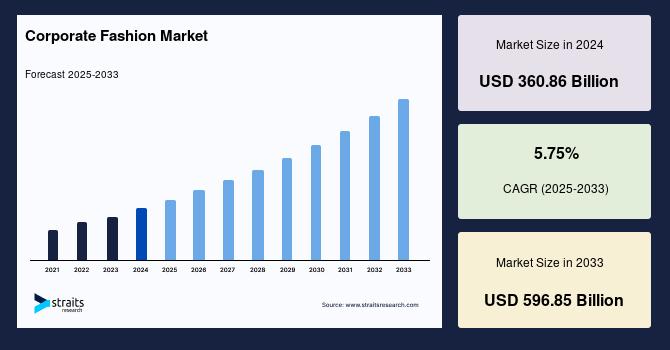Introduction
The corporate fashion market represents a vital segment of the global apparel industry, focusing on professional clothing, uniforms, and branded corporate attire. Companies around the world increasingly recognize the importance of professional appearance in reinforcing brand identity, boosting employee confidence, and fostering organizational unity. From formal suits and blazers to industry-specific uniforms, corporate fashion blends functionality with aesthetics, catering to a wide spectrum of workplaces, including offices, hospitality, healthcare, aviation, retail, and security sectors.
Market Overview
The global corporate fashion market size was valued at USD 360.86 billion in 2024 and is projected to grow from USD 381.61 billion in 2025 to reach USD 596.85 billion by 2033, growing at a CAGR of 5.75% during the forecast period (2025–2033).
Corporate fashion encompasses several categories:
-
Formal Workwear: Suits, shirts, trousers, skirts, and blazers designed for traditional office environments.
-
Smart Casual Attire: Polo shirts, chinos, cardigans, and versatile layers suitable for flexible and hybrid work cultures.
-
Industry-Specific Uniforms: Healthcare scrubs, hospitality uniforms, aviation attire, retail staff clothing, and security uniforms.
-
Accessories: Ties, scarves, belts, and footwear designed to complement corporate outfits and enhance overall presentation.
Key Market Drivers
1. Branding and Corporate Identity
Businesses increasingly view corporate attire as a strategic tool to reinforce brand identity. Uniforms and branded clothing create a cohesive appearance, instill team spirit, and project professionalism to clients and stakeholders. Corporates are investing in high-quality, stylish, and functional clothing to align employee presentation with the company’s brand values.
2. Sustainability and Ethical Fashion
Sustainability has emerged as a significant driver in the corporate fashion market. Companies are emphasizing eco-friendly materials, ethically sourced fabrics, and production processes that minimize environmental impact. By integrating sustainable attire into their operations, organizations not only reduce their carbon footprint but also enhance corporate social responsibility (CSR) initiatives, appealing to environmentally conscious employees and customers.
3. Customization and Personalization
The growing demand for customized corporate clothing allows employees to feel valued and confident. Tailored suits, personalized shirts, and branded uniforms enhance employee satisfaction and foster a sense of belonging. Customization also ensures that corporate attire aligns with organizational aesthetics while accommodating diverse body types, comfort preferences, and cultural considerations.
4. Adapting to Remote and Hybrid Work Models
The global shift toward remote and hybrid working has influenced corporate fashion. Companies now seek versatile clothing that balances professionalism with comfort, suitable for office, remote, or client-facing environments. Smart casual attire, flexible fabrics, and modular wardrobe pieces have become increasingly popular as organizations redefine workplace dress codes.
Market Segmentation
By Product Type
-
Formal Wear: Suits, shirts, blouses, trousers, and skirts.
-
Smart Casual Wear: Polo shirts, chinos, cardigans, and blazers.
-
Industry-Specific Uniforms: Healthcare scrubs, hospitality uniforms, aviation attire, retail staff uniforms, and security uniforms.
-
Accessories: Ties, scarves, belts, and footwear.
By End User
-
Men
-
Women
-
Unisex: Products designed for flexibility and inclusivity.
By Distribution Channel
-
Offline Retail: Brick-and-mortar stores offering hands-on fittings and personalized services.
-
Online Retail: E-commerce platforms providing convenience, wide product selection, and delivery options.
By Region
-
North America: Dominates the market with a strong corporate sector, high professional standards, and increasing adoption of branded corporate attire.
-
Europe: Significant market share driven by established fashion trends, regulatory requirements, and sustainable fashion adoption.
-
Asia-Pacific: Fastest-growing region due to expanding economies, rising corporate establishments, and growing awareness of professional dress codes.
-
Latin America: Emerging corporate sectors and increasing demand for branded workwear.
-
Middle East & Africa: Market growth fueled by hospitality, aviation, and security industries, alongside urbanization and international business growth.
Regional Insights
-
North America: The market is mature, characterized by established corporate sectors and emphasis on image and branding. Sustainability and personalization trends are shaping corporate attire strategies.
-
Asia-Pacific: Exhibiting rapid growth due to industrialization, rising middle-class workforce, and increased emphasis on professional presentation in urban corporate environments.
-
Europe: Focus on eco-friendly materials, corporate social responsibility, and adherence to strict labor and environmental regulations drives the demand for sustainable corporate fashion.
-
Other Regions: Latin America and the Middle East & Africa are expanding markets with growing corporate and hospitality sectors, emphasizing standardized uniforms and professional appearance.
Emerging Trends
-
Eco-Friendly Fabrics: Adoption of organic cotton, recycled polyester, and biodegradable textiles.
-
Smart Clothing: Incorporating technology for comfort, temperature regulation, and performance monitoring.
-
Inclusive Fashion: Designing corporate attire that accommodates diverse body types, genders, and cultural norms.
-
Flexible Workwear: Multi-functional clothing suitable for both in-office and remote working environments.
Challenges
-
Cost Considerations: High-quality fabrics, customization, and sustainable materials increase overall production costs.
-
Balancing Fashion and Functionality: Companies must provide clothing that is both aesthetically appealing and comfortable for diverse work environments.
-
Global Standardization: Differences in corporate culture, climate, and fashion preferences across regions make uniform standardization challenging.
Future Outlook
The corporate fashion market is expected to continue its steady growth trajectory. Companies will increasingly invest in sustainable, customizable, and versatile attire to enhance employee satisfaction and brand identity. The integration of smart textiles, flexible designs, and eco-friendly production will define the next generation of corporate fashion. Growth in emerging markets, coupled with technological advancements in fabric and garment manufacturing, is likely to create new opportunities for innovative corporate fashion solutions worldwide.
Conclusion
Corporate fashion is more than just clothing it is a strategic tool that strengthens brand identity, promotes professional presentation, and reflects organizational values. With sustainability, customization, and adaptability as key market drivers, the corporate fashion industry is evolving rapidly. As businesses strive to balance employee comfort, brand aesthetics, and environmental responsibility, corporate fashion will continue to play a pivotal role in shaping modern workplaces and professional identity.

